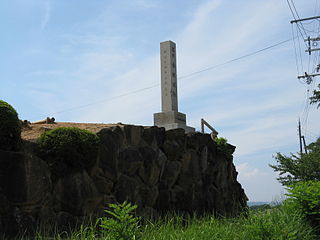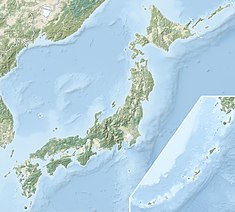
Prince Moriyoshi was a Japanese prince and monk.
Takanosu was a town located in Kitaakita District, Akita Prefecture, Japan.

Moriyoshi was a town located in Kitaakita District, Akita Prefecture, Japan.

Ani was a town located in Kitaakita District, Akita Prefecture, Japan.

Aikawa was a town located in Kitaakita District, Akita Prefecture, Japan.

Kitaakita District is a rural district located in Akita Prefecture, Japan.
Susumu Ojima is a Japanese entrepreneur who was a founder and chairman of Huser Co., Ltd.

Chihaya Castle is a late Kamakura period Japanese castle located in the village of Chihayaakasaka, Osaka Prefecture, Japan. Its ruins have been protected as a National Historic Site since 1934.

Kujō Moronori, son of regent Tadanori, was a kugyō or Japanese court noble of the Kamakura period (1185–1333). He held regent positions kampaku from 1305 to 1308 and sessho in 1308. A daughter of Emperor Kameyama was his consort; the couple adopted his brother Fusazane as their son. His other consort gave birth to Michinori who was in turn adopted by Fusazane.
Kujō Michinori, son of Moronori with Imperial Prince Moriyoshi’s daughter and adopted son of Fusazane, was a kugyō or Japanese court noble of the Kamakura period (1185–1333). He held a regent position kampaku in 1342. He married Oomiya Suehira’s daughter. Tsunenori was his adopted son.

The Akita Nairiku Line is a Japanese railway line located in Akita Prefecture in northern Japan. It operates between Takanosu in the city of Kitaakita and Kakunodate in the city of Senboku. The Akita Nariku Line is the only railway line operated by the Akita Nairiku Jūkan Railway.
The Japan–India Association is a foundation headquartered in the Suzuko Building in Nihonbashi, Chuo, Tokyo.

Maeda-Minami Station is a railway station located in the city of Kitaakita, Akita Prefecture, Japan, operated by the third sector railway operator Akita Nairiku Jūkan Railway.

Katsurae Station is a railway station located in the city of Kitaakita, Akita Prefecture, Japan, operated by the third sector railway operator Akita Nairiku Jūkan Railway.

Yonzaizawa Station is a railway station located in the city of Kitaakita, Akita Prefecture, Japan, operated by the third sector railway operator Akita Nairiku Jūkan Railway.
Jikō Higashifushimi, born Moriyoshi Higashifushimi, is the Chief Abbot of the Shōren-in Temple in Kyoto, Japan. He is also the Governor of Dai Nippon Butoku Kai and a cousin to the Emperor Akihito of Japan as well as the son of Higashifushimi Kunihide.

Kami-Akasaka Castle is a late Kamakura period Japanese castle located in the village of Chihayaakasaka, Osaka Prefecture, Japan. Its ruins have been protected as a National Historic Site since 1934. It is also referred to as Kusunoki Castle or Kiriyama Castle,

Shimo-Akasaka Castle is a late Kamakura period Japanese castle located in the village of Chihayaakasaka, Osaka Prefecture, Japan. Its ruins have been protected as a National Historic Site since 1934. It is also referred to as simply Akasaka Castle.













